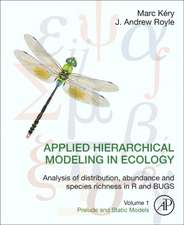Distance Sampling: Methods and Applications: Methods in Statistical Ecology
Autor S. T. Buckland, E.A. Rexstad, T.A. Marques, C.S. Oedekovenen Limba Engleză Hardback – 24 aug 2015
Distance sampling refers to a suite of methods, including line and point transect sampling, in which animal density or abundance is estimated from a sample of distances to detected individuals. The book illustrates these methods through case studies; data sets and computer code are supplied to readers through the book’s accompanying website. Some of the case studies use the software Distance, while others use R code. The book is in three parts. The first part addresses basic methods, the design of surveys, distance sampling experiments, field methods and data issues. The second part develops a range of modelling approaches for distance sampling data. The third part describes variations in the basic method; discusses special issues that arise when sampling different taxa (songbirds, seabirds, cetaceans, primates, ungulates, butterflies, and plants); considers advances to deal with failures of the key assumptions; and provides a check-list for those conducting surveys.
| Toate formatele și edițiile | Preț | Express |
|---|---|---|
| Paperback (1) | 733.61 lei 38-45 zile | |
| Springer International Publishing – 22 oct 2016 | 733.61 lei 38-45 zile | |
| Hardback (1) | 751.52 lei 38-45 zile | |
| Springer International Publishing – 24 aug 2015 | 751.52 lei 38-45 zile |
Preț: 751.52 lei
Preț vechi: 988.84 lei
-24% Nou
143.81€ • 153.78$ • 119.90£
Carte tipărită la comandă
Livrare economică 14-21 aprilie
Specificații
ISBN-10: 3319192183
Pagini: 277
Ilustrații: XV, 277 p. 80 illus.
Dimensiuni: 155 x 235 x 22 mm
Greutate: 0.71 kg
Ediția:1st ed. 2015
Editura: Springer International Publishing
Colecția Springer
Seria Methods in Statistical Ecology
Locul publicării:Cham, Switzerland
Public țintă
ResearchCuprins
Introduction.- The basic methods.- Designing surveys.- Designing distance sampling experiments.- Field methods and data checking.- Modelling detection functions.- Design-based estimation of animal density and abundance.- Model-based distance sampling: two-stage models.- Model-based distance sampling: full likelihood methods.- Variations on a theme.- Taxon-specific issues.- Exchanging assumptions for data.- Summary.
Recenzii
Textul de pe ultima copertă
In this book, the authors cover the basic methods and advances within distance sampling that are most valuable to practitioners and in ecology more broadly. This is the fourth book dedicated to distance sampling. In the decade since the last book published, there have been a number of new developments. The intervening years have also shown which advances are of most use. This self-contained book covers topics from the previous publications, while also including recent developments in method, software and application.
Distance sampling refers to a suite of methods, including line and point transect sampling, in which animal density or abundance is estimated from a sample of distances to detected individuals. The book illustrates these methods through case studies; data sets and computer code are supplied to readers through the book’s accompanying website. Some of the case studies use the software Distance, while others use R code. The book is in three parts. The first part addresses basic methods, the design of surveys, distance sampling experiments, field methods and data issues. The second part develops a range of modelling approaches for distance sampling data. The third part describes variations in the basic method; discusses special issues that arise when sampling different taxa (songbirds, seabirds, cetaceans, primates, ungulates, butterflies, and plants); considers advances to deal with failures of the key assumptions; and provides a check-list for those conducting surveys.
Caracteristici
Includes theory for designed experiments in distance sampling
Has examples using R in addition to the Distance software
Couples case studies with accessible datasets and software to allow readers to apply methods in a variety of contexts
Descriere
In this book, the authors cover the basic methods and advances within distance sampling that are most valuable to practitioners and in ecology more broadly. This is the fourth book dedicated to distance sampling. In the decade since the last book published, there have been a number of new developments. The intervening years have also shown which advances are of most use. This self-contained book covers topics from the previous publications, while also including recent developments in method, software and application.
Distance sampling refers to a suite of methods, including line and point transect sampling, in which animal density or abundance is estimated from a sample of distances to detected individuals. The book illustrates these methods through case studies; data sets and computer code are supplied to readers through the book’s accompanying website. Some of the case studies use the software Distance, while others use R code. The book is in three parts. The first part addresses basic methods, the design of surveys, distance sampling experiments, field methods and data issues. The second part develops a range of modelling approaches for distance sampling data. The third part describes variations in the basic method; discusses special issues that arise when sampling different taxa (songbirds, seabirds, cetaceans, primates, ungulates, butterflies, and plants); considers advances to deal with failures of the key assumptions; and provides a check-list for those conducting surveys.















